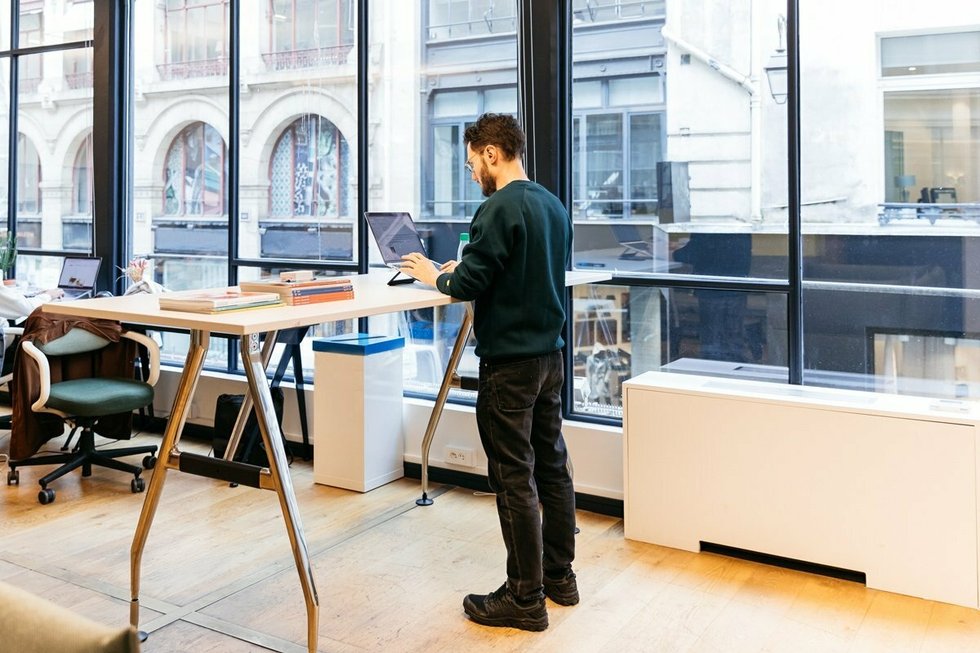Standing up: do we work better on our two feet?
Oct 14, 2021
5 mins

CH
Journaliste indépendante
In some open-plan offices, there are those unique souls who stand out for their physically dynamic ways of working. Rather than sitting in a chair staring at a screen: these workers of the future proudly stay on their feet. Whether using a standing desk, holding an iPad, or getting their 10,000 steps while making phone calls, they function vertically. You might wonder why they are doing this. Is it better to work while standing up? Could it be better for your health? We went looking for answers.
Was David Bowie right when he sang “Don’t sit down”? In some open-plan offices, many staff has started to avoid sitting down too much for a variety of reasons. Romain, 31, doubled down on this way of working during the first lockdown. “Our habits changed within the company during the pandemic,” he said. “Instead of in-person meetings where we stay seated, we checked in more often by phone. I ended up making my calls while standing up and pacing about. I had been doing this before, but it happened more frequently during Covid.”
For this sales director in a consulting firm, it’s all about being more focused during calls and being able to “walk around to clear my head to better focus on my ideas”. Working standing up is stimulating for him, but not all his colleagues appreciate his habit. “They sometimes need it to be silent, so they don’t like seeing someone moving around them,” he said. It helps Romain with his concentration, but is it actually healthier?
Get active to be healthy!
In recent years, we have been made aware of the health risks associated with a sedentary lifestyle. According to a British Psychological Society study, the staff stays seated in their chairs for five and a half hours a day. That’s a worrying statistic given that it’s believed that inactivity is responsible for 27% of diabetes cases and 95% of back pain. Alexandre, an osteopath in Paris, says he sees patients with pain due to their jobs every day. “In the big cities, there are a lot of sedentary jobs with people sitting at desks. They end up with a lot of neck and back pain,” he said. The specialist explains that working in a seated position for too long is not a good thing. “This somewhat cramped position increases the pressure on the intervertebral discs,” he said. “All the muscles in the back are working very little. This reduces muscle tone as well as circulation because the venous return is mainly through the lower body.”
Antoine-Benjamin, 40, knew these pains all too well. In his previous role, the chief marketing officer used to travel extensively, often taking flights to meetings. “I started having major pain from sitting all the time,” he said. He did his research and learned about the dangers of being sedentary at work. He now works for Facebook and he’s become adept at working standing up, thanks to the furniture in place at the US company. “Everyone there has a height-adjustable desk. Ever since I started working standing up, I’ve had a lot less pain,” he said. While he hasn’t noticed any major changes in his ability to focus, he has noticed a difference in his creativity levels when his body is active. “Some offices even have treadmill desks. You can make calls while walking,” he said. “It made me feel more creative. It was exciting.”
Standing up against the odds?
So should we all get out of our chairs and work standing up so that we can have better posture? Well, not all companies are equal in terms of the resources they make available to their staff, according to Anthony, 32, a physiotherapist who often consults for companies giving their staff ergonomic advice. “Working at a standing desk is a good alternative, but it is not very common in practice. Even in newer offices, only 10% of workstations have this setup. It’s not necessarily available to everyone and, as some companies operate hot desking, it’s first come, first served.”
So you have to make do with what you’ve got, or what you haven’t got. That’s what Adrien, the chief executive of a financial consulting firm, has done. The thirtysomething was inspired by large companies such as Amazon, which were setting up new ways of working, including mobile desks “to improve posture at work”. For him, it’s a way to keep moving and to foster a more dynamic mindset. “Standing up gets you thinking differently. You’re much more active rather than just sitting and being passive. Working on your feet gives you more of an impression that things are constantly changing, that projects are moving forward,” he said.
Always up for a challenge, Adrien counts the steps he takes while on the phone and takes his computer with him everywhere and he is never embarrassed to do so. Some of his colleagues are surprised to see him operate this way, though others have followed suit. For Antoine-Benjamin, his desire to work standing up has had an impact on his colleagues. “It starts a conversation, people are intrigued and they sometimes want to try it too,” he said. Adrien notes that you have to know how to adapt. He’s not always able to stand in meetings and he’s forced to switch it up. That might be for the better, according to the osteopath, who says standing up all day isn’t the ideal solution either.
Switching it up is key
“It’s quite good to switch between sitting and standing. You shouldn’t be standing the entire day. Your body doesn’t like to be in the same position all the time. It likes to move,” Alexandre said. He also encourages staff to find a way to move about at least once every hour. To ensure that you do so, here are some tips:
Put the photocopier in a spot where staff have to walk over to it
Take short five-minute walks around the office
Have complimentary coffee or tea available for staff throughout the building
Switching between seated and standing positions is ideal. The osteopath says patients who change their work habits and their working posture regularly see the benefits of doing so. “They feel less tired and more productive. And most importantly, they avoid chronic pain,” he said.
Making or taking phone calls while standing up, thinking while on the move, and switching positions regularly will all let you take better care of your body at work and honor the adage: a healthy mind in a healthy body. And to minimize the chances of injuring your neck or back when switching positions, Anthony has a few tips that he regularly shares with his patients:
Put a jumper or a rolled towel between your pelvis and your chair, to let your pelvis rest and to avoid arching your back
Try to have your elbows aligned on the same level as your hands
Position your computer so that the top of the screen is at eye level
Stretch your neck and shoulders by holding your hands together behind your back and pulling them to one side and then to the other
What’s important to remember is that your body needs to be in a relaxed position to not create too much tension. As Adrien says, “It’s sad to be stuck behind your desk. It’s like you’re working on an assembly line. Moving around is much more inspiring!”
So let’s get on our feet and get to work!
Translated by Kalin Linsberg
Photo by Welcome to the Jungle
Follow Welcome to the Jungle on Facebook on LinkedIn and on Instagram and subscribe to our newsletter to get our latest articles every day!

More inspiration: Productivity & tools

Goal setting: How to bounce back when you feel like a failure
The big F word ... Failure. We all face it, but here’s how to make it your secret weapon for success.
Dec 18, 2024

Productivity boost: Why mental health outshines long hours
Long hours don’t equal better work. Discover how mental health support can unlock productivity and time efficiency in the workplace.
Nov 28, 2024

10 fun ways people are using AI at work
While many use AI for basic tasks like grammar checks or voice assistants, others are finding innovative ways to spice up their work days.
Nov 05, 2024

12 Slack habits that drive us crazy
Slack is a top messaging platform, but coworkers can misuse it. Over-tagging and endless messages can make it frustrating ...
Oct 16, 2024

10 CareerTok creators you should be following
Looking for career advice? CareerTok has quick tips from real experts on interviews and job offers.
Sep 25, 2024
The newsletter that does the job
Want to keep up with the latest articles? Twice a week you can receive stories, jobs, and tips in your inbox.

Looking for your next job?
Over 200,000 people have found a job with Welcome to the Jungle.
Explore jobs